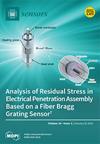ICDW-YOLO:高效的木结构裂缝检测算法
IF 3.4
3区 综合性期刊
Q2 CHEMISTRY, ANALYTICAL
引用次数: 0
摘要
对于生产和建筑保护而言,一种对小目标敏感的可靠木质材料裂缝检测算法是不可或缺的。然而,由于木质材料中裂纹的尺度差异很大,而且现有数据的质量不稳定,因此精确识别和定位木质材料中的裂纹是一项挑战。为此,我们利用 YOLOv8 模型的先进性,提出了一种专门针对木质材料的裂纹检测算法,并将其命名为 ICDW-YOLO(木质材料裂纹检测改进-YOLO)。ICDW-YOLO 模型引入了颈部网络和层结构的新设计以及锚点算法,该算法具有双层关注机制和动态梯度增益特性,可优化和增强原始模型。最初,利用 GSConv 和 GS 瓶颈设计了一种新的层结构,通过最大限度地保留隐通道连接来提高模型的识别准确率。随后,通过收集-分配机制对网络进行了改进,旨在增强多尺度特征的融合能力,并引入更高分辨率的输入层来提高小目标的识别能力。通过定制的木质材料裂缝检测数据集获得的经验结果表明,所提出的 ICDW-YOLO 算法能够有效地检测目标。在不大幅增加模型复杂度的情况下,mAP50-95 指标达到了 79.018%,比 YOLOv8 提高了 1.869%。通过对火灾和烟雾探测数据集、航空遥感图像数据集和 coco128 数据集的实验,进一步验证了我们算法的有效性。结果表明,ICDW-YOLO 的 mAP50 高达 69.226%,mAP50-95 高达 44.210%,这表明 ICDW-YOLO 与最先进的检测器相比具有强大的泛化能力和竞争力。本文章由计算机程序翻译,如有差异,请以英文原文为准。
ICDW-YOLO: An Efficient Timber Construction Crack Detection Algorithm
A robust wood material crack detection algorithm, sensitive to small targets, is indispensable for production and building protection. However, the precise identification and localization of cracks in wooden materials present challenges owing to significant scale variations among cracks and the irregular quality of existing data. In response, we propose a crack detection algorithm tailored to wooden materials, leveraging advancements in the YOLOv8 model, named ICDW-YOLO (improved crack detection for wooden material-YOLO). The ICDW-YOLO model introduces novel designs for the neck network and layer structure, along with an anchor algorithm, which features a dual-layer attention mechanism and dynamic gradient gain characteristics to optimize and enhance the original model. Initially, a new layer structure was crafted using GSConv and GS bottleneck, improving the model’s recognition accuracy by maximizing the preservation of hidden channel connections. Subsequently, enhancements to the network are achieved through the gather–distribute mechanism, aimed at augmenting the fusion capability of multi-scale features and introducing a higher-resolution input layer to enhance small target recognition. Empirical results obtained from a customized wooden material crack detection dataset demonstrate the efficacy of the proposed ICDW-YOLO algorithm in effectively detecting targets. Without significant augmentation in model complexity, the mAP50–95 metric attains 79.018%, marking a 1.869% improvement over YOLOv8. Further validation of our algorithm’s effectiveness is conducted through experiments on fire and smoke detection datasets, aerial remote sensing image datasets, and the coco128 dataset. The results showcase that ICDW-YOLO achieves a mAP50 of 69.226% and a mAP50–95 of 44.210%, indicating robust generalization and competitiveness vis-à-vis state-of-the-art detectors.
求助全文
通过发布文献求助,成功后即可免费获取论文全文。
去求助
来源期刊

Sensors
工程技术-电化学
CiteScore
7.30
自引率
12.80%
发文量
8430
审稿时长
1.7 months
期刊介绍:
Sensors (ISSN 1424-8220) provides an advanced forum for the science and technology of sensors and biosensors. It publishes reviews (including comprehensive reviews on the complete sensors products), regular research papers and short notes. Our aim is to encourage scientists to publish their experimental and theoretical results in as much detail as possible. There is no restriction on the length of the papers. The full experimental details must be provided so that the results can be reproduced.
 求助内容:
求助内容: 应助结果提醒方式:
应助结果提醒方式:


